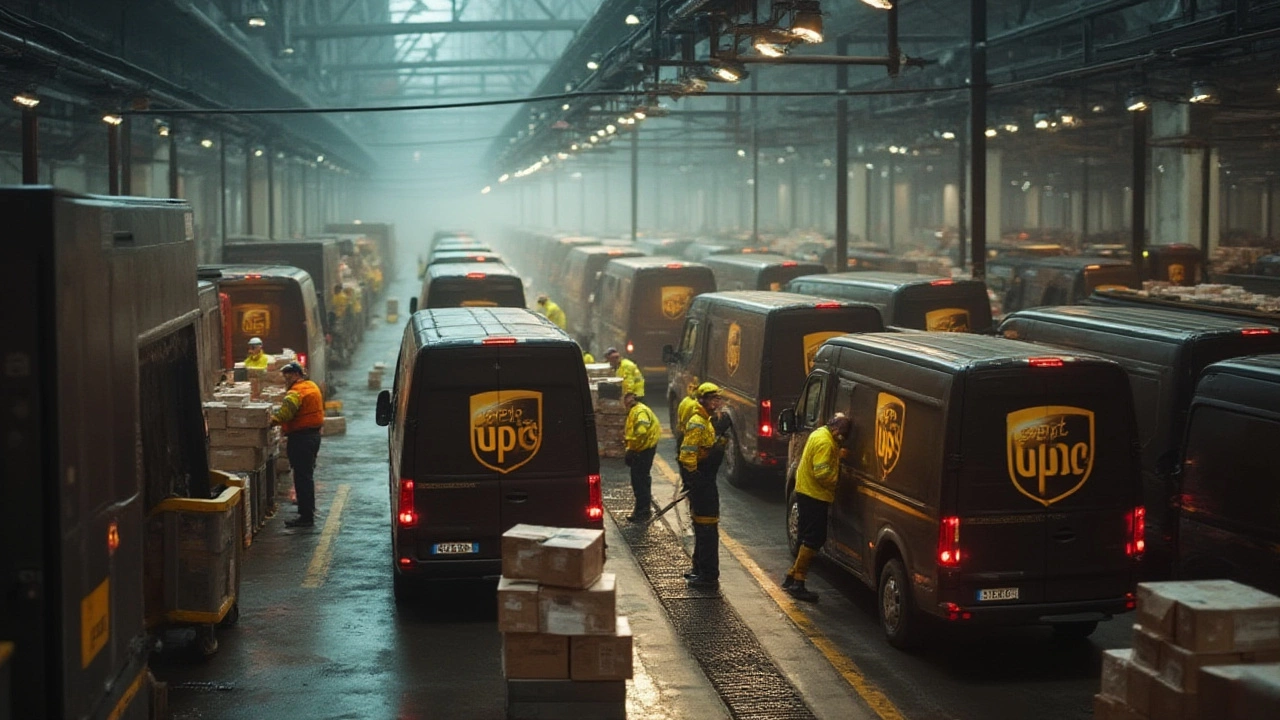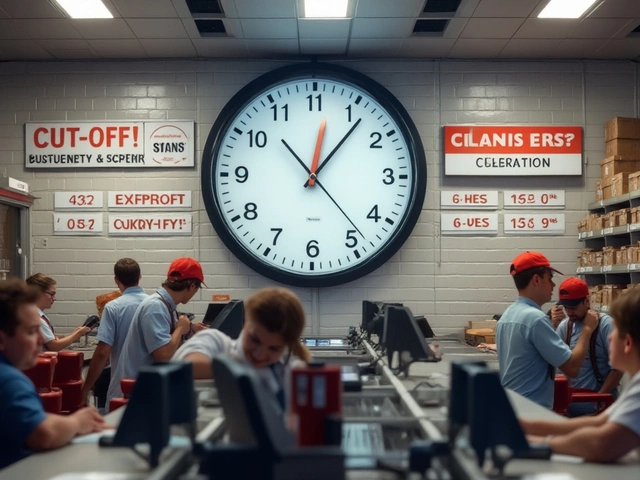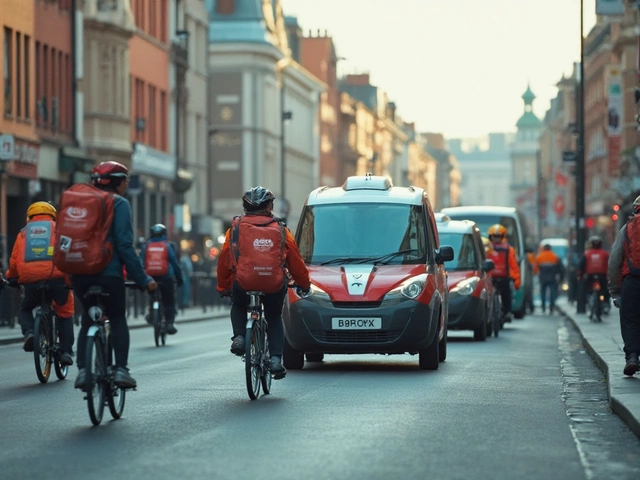Ever wondered who keeps all the online shopping, food deliveries, and every last-minute replacement part moving across the US—all without you even thinking about it? Hidden in plain sight, the world’s largest logistics machine is always working. Trucks roll down highways no matter the hour, airplanes lift off into the dark, and thousands of workers scan barcodes like an orchestra, all so your dog’s favorite treat arrives right on time. At the heart of this massive and intricate show is a company whose brown trucks are as common as Starbucks on Main Street: UPS.
How UPS Rose to the Top of US Logistics
UPS, which casually stands for United Parcel Service, is a name most folks associate with quick package delivery and those familiar brown uniforms. Its journey began back in 1907, in Seattle—long before e-commerce sprang to life. What started as a humble messenger service quickly morphed into a logistics giant after decades of innovation and some savvy strategy.
UPS clinched its spot as the largest US logistics company by handling everything from single packages to multi-ton freight for both businesses and consumers. Each day, they deliver over 20 million parcels and documents. That’s not just a couple of truckloads. We’re talking enough to keep entire cities humming. They employ nearly half a million people worldwide—close to 370,000 just in the US.
For something so big, speed is everything. UPS operates a vast fleet: over 120,000 vehicles (from gas, electric, to hybrid) and nearly 600 aircraft in their global air fleet. What’s wild is that their logistics network is so optimized that your package can travel across the country in a single night. And yes, they use sophisticated AI-powered route planning, plus huge automated hubs, like the mammoth Worldport facility in Louisville, Kentucky. Worldport alone handles 416,000 packages every hour. It’s a sea of conveyor belts, robotic arms, and workers in yellow vests, moving at the speed of caffeine. No wonder analysts call it the “heart and lungs” of the company.
The magic isn’t just size, but precision. UPS’s technology gives customers minute-by-minute updates. And if you want your sneakers by noon tomorrow, they’ll probably beat their own promise. They’ve kept up with the seismic shift to e-commerce, powering Amazon, Shopify merchants, local mom-and-pops… You name it. They even help big brands like Nike, 3M, and Pfizer run their global supply chains.
UPS isn’t just about parcels, though. They have a robust freight operation, supply chain management, healthcare logistics, and even special solutions for temperature-sensitive items. They don’t just drop boxes at your door. They’ll move entire warehouses’ worth of critical inventory, manage customs for international shipments, and design delivery plans for complicated situations—think pandemics, vaccines, or disaster relief supplies. During the COVID-19 crisis, UPS delivered hundreds of millions of vaccines across the US and beyond, coordinating cold-chain logistics that most companies couldn’t handle.
If you’re wondering whether they’ve ever stopped growing, here’s a table showing their massive reach in 2024:
| Metric | UPS 2024 Data |
|---|---|
| Employees (US) | ~370,000 |
| Vehicles Operated | 120,000+ |
| Aircraft in Fleet | ~600 |
| Parcels Handled Daily (Global) | 20.6 million |
| Annual Revenue | $94.4 billion USD |
| Automated Sorting Hubs (US) | 25 |
Fun fact: UPS drivers rarely turn left. Their routing software prefers right turns to save fuel, cut delays, and reduce accidents. This one little tweak saves the company millions of liters of fuel each year. It goes to show that the true strength of UPS isn’t just moving stuff—it’s obsessing over every detail, every second of every day.

Who Are UPS’s Main Rivals, and Why Do They Fall Behind?
People often lump UPS in with FedEx—the company famous for its purple-and-orange logo and “When it absolutely, positively has to be there overnight.” FedEx is big. Like, $90 billion-revenue big. But UPS edges them out in several critical ways. UPS’s daily package volume, employee count, and US market share have stayed consistently higher over the years. In fact, in the trucking and parcel delivery arena, UPS has about 24% of the American market, while FedEx hovers around 19%.
Why haven’t these rivals snatched the top spot? It comes down to scale, innovation, and a focus that borders on obsession. UPS put tons of money into their infrastructure long before e-commerce hit its boom. They automate like crazy—25 US sorting facilities run with the help of AI. Their drivers are famous for razor-sharp efficiency; some even joke that you can set your watch by the local UPS truck.
Then there are the public postal services. The USPS is huge, and, by certain numbers (like actual pieces of mail), it’s unmatched. But when it comes to logistics tech, reliability, and big-ticket e-commerce contracts, private companies like UPS lead. USPS can deliver everywhere but mostly stick to letters, flyers, and small parcels. And it’s no secret—they partner with UPS and FedEx for bulkier packages anyway.
Don’t overlook Amazon Logistics. It’s the new kid on the block. With a growing army of Sprinter vans and dazzling data, Amazon handles roughly 23% of its own US deliveries now. Still, they’re not really a logistics company for anyone but themselves (not yet, anyway). Most brands and independent stores still lean on UPS for nationwide reach, reliability, and the flexibility to handle huge peaks around Black Friday, Christmas, and back-to-school shopping sprees.
Here’s a quick side-by-side of the key numbers for the top three (2024):
| Company | Revenue (USD) | US Employees | Daily Parcels (Global) |
|---|---|---|---|
| UPS | $94.4B | ~370,000 | 20.6M |
| FedEx | $90.2B | ~210,000 | 16.5M |
| Amazon Logistics* | ~$53B (est.) | ~275,000 | 10M (AMZ only) |
*Amazon’s total logistics share is an estimate and includes transportation, not third-party contract work.
So, what stops everyone else from challenging UPS seriously? Money, tech, and, honestly, a bit of culture. UPS invests billions yearly in innovation—whether it’s electric trucks, drone tests, or new AI. Their logistics crew is just relentless about shaving seconds from every route and squeezing more reliability out of every shift. And customers notice. It’s a trust thing; if your main supply line is at stake, you go with the team that’s proven they can handle anything the world throws at them.
Another thing: UPS’s network is so deep, they can promise next- or two-day delivery almost anywhere in the US, even remote rural towns. Their competitors still have to play catch-up in many places.
One tip for smaller businesses: UPS offers volume discounts and tons of business tools, so don’t count them out if you’re starting small. Their online shipping calculator and integrated Shopify support make life so much easier—and if you play it right, you can get e-commerce rates that are pretty competitive with even the big retailers.

Hidden Superpowers: What Makes UPS Logistics Unbeatable?
At first glance, you might think UPS’s edge is just size or history. Dig deeper and it’s clear: their real muscle is in analytics, operational discipline, and raw agility. UPS invests heavily in data science to predict parcel surges (like during a surprise viral TikTok trend or a sudden cold snap). They tweak delivery schedules in real time based on weather, traffic, or even big football games.
The company’s “ORION” system (On-Road Integrated Optimization and Navigation) took over a decade and $295 million USD to develop. ORION calculates the shortest, fastest, most fuel-efficient route for each driver’s deliveries—literally re-routing in real time. This monster algorithm can handle billions of delivery options each minute. Since rolling it out, UPS has shaved 100 million miles off its annual driving distance. That saves them 10 million gallons of petrol per year, slashes emissions, and gives drivers more time to grab lunch. ORION is exclusive—no competitor has anything quite as powerful.
Automation isn’t just for nerd cred, though. At Worldport and other hubs, robotic arms and scanners sort packages faster than a team of caffeinated college students during finals week. This lets UPS clear rushes (think Amazon Prime Day) that would drown less-prepared carriers. Their network is so interconnected, they can shift resources—drivers, planes, packages—at a moment’s notice if strong storms or wildfires threaten a region. That flexibility means fewer delays, even when the world gets thrown a curveball.
Security and sustainability are big, too. UPS has invested in two massive solar power arrays in the US, they’re pushing toward a 40% “alternative fuel” vehicle fleet by 2030, and they target zero emissions in operations and facilities by 2050. On security: UPS’s parcel tracking is so detailed, you can follow a package’s route almost down to the hour. Their fraud monitoring system (“Package Intercept”) can stop a stolen parcel in its tracks. They even have special “high value” courier teams for things like electronics, jewelry, or pharmaceuticals.
UPS is also quietly shaping the future of logistics. They’re piloting drone deliveries, looking at using autonomous trucks, and collaborating with startups on micro-fulfilment centers closer to customers. During the pandemic, when vaccines needed to move literally colder than ice cream, UPS used 3D-printed “smart” labels to track temps and locations—pretty wild.
There’s another superpower: their people. The UPS driver isn’t just a delivery person; they’re a logistics ninja. It takes weeks to learn every detail of a standard UPS route, and drivers often work with the same neighborhoods for years. That trust and consistency strengthens the brand more than any marketing campaign ever could.
If you want to make the most of UPS—either as a business or a regular customer—here are a few quick tips:
- Sign up for a free UPS My Choice account to get real-time delivery alerts and reschedule packages.
- Use UPS Access Point lockers if you can’t be at home; they’re in tons of pharmacies, grocery stores, and even newsagents.
- If you’re shipping for your business, check out the UPS Small Business Program. It can save you more money than you’d expect, even with modest volumes.
- Keep peak shipping seasons in mind (pre-Christmas, Mother’s Day, back-to-school). Schedule pickups a bit earlier to dodge last-minute surcharges.
- Use UPS’s carbon-neutral shipping option; it might just get your customers to smile a little wider when they open their order.
UPS isn’t just a company that delivers boxes. In 2025, they’re the backbone of an economy where speed matters, and trust means everything. They got there with relentless focus, jaw-dropping tech investments, and the quiet pride of those brown-clad drivers who never leave a package behind. If you want to see what modern logistics looks like, look for the next brown truck in your neighborhood—it’s probably dragging half the local supply chain in its wake.





